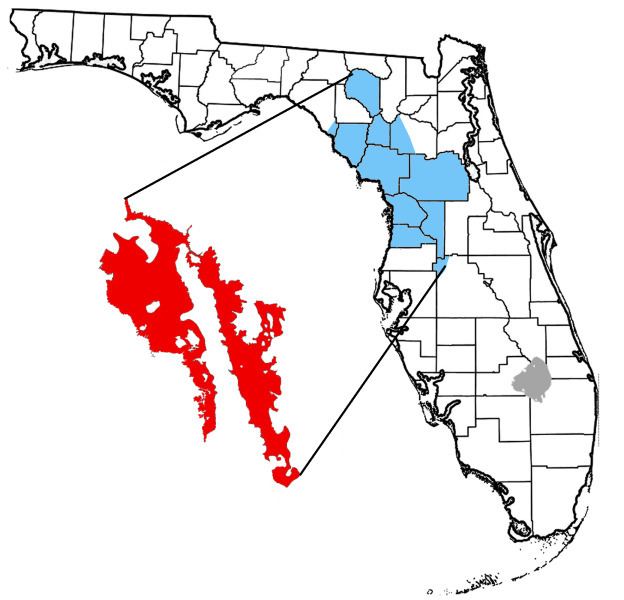The Hawthorn Group is a Late Oligocene to Pliocene grouping of several geologic formations and members in North Florida, United States.
The Hawthorn Group was originally called the Waldo Formation in 1887 by L. C. Johnson of the USGS and became Hawthorne beds for sediments being quarried and ground up as fertilizer near Hawthorne, Florida.
Period: Neogene
Epoch: Miocene
Faunal stage: Chattian through early Blancan ~28.4 to ~2.588 mya, calculates to a period of 25.512 million years
The Hawthorn Group extends from Suwannee County in the north and southward to Hernando County. It encompasses in part the counties of Gilchrist, Levy, Dixie, Citrus, Sumter, Alachua and Marion County. The Hawthorn is also present below undifferentiated sediments (TQu) as well as the Tamiami Formation from Polk County south through Highlands, Glades, Hendry, Dade, Collier, and Monroe County at depths ranging from mean sea level near Polk to below 600 meters in Monroe Co. The Hawthorn overlies Ocala Limestone
Arcadia Formation
Coosawhatchie Formation (Miocene-Pliocene)
Peace River Formation (Miocene-Pliocene)
Statenville Formation (Miocene)
Torreya Formation (Miocene)
Reptiles
Apalone ferox (Florida Softshell Turtle)
Pseudemys caelata (Pond Turtle)
Terrapene (Box Turtle)
Deirochelys (Chicken Turtle)
Geochelone (Tortoise)
Alligator mississippiensis (American Alligator)
†Gavialosuchus americanus or Thecachampsa antiqua (American Crocodile)
Typhlops (Blind snake)
Xenodontinae (Mud Snake)
Heterodon (Hognose Snake)
Elaphe (Rat Snake)
Lampropeltis getulus (Kingsnake)
Nerodia (Water snake)
Thamnophis (Garter Snake)
Crotalinae (Lancehead, Rattlesnake)
Sistrurus (Rattlesnake)
Birds
Anserinae (Swan)
Podicipedidae (Grebe)
Phalacrocoracidae (Cormorant)
Anhinga grandis (Snakebird)
Ciconiidae (Stork)
Phoenicopteridae (Flamingo)
Ardea (Heron)
Egretta (Egret)
Ardeola (Heron)
Aramidae (Limpkin)
Gruidae (Crane-like)
Rallidae (Crakes & Coots)
Cathartidae (New World Vulture)
Pandionidae (Osprey)
Accipitridae (Eagle)
Passeriformes (Songbird)
Mammals
†Metaxytherium floridanum (Sea Cow)
†Gomphotherium (Elephant)
†Tapirus simpsoni (Tapir)
†Teleoceras proterum (Rhinoceros)
†Aphelops malacorhinus (Rhinoceros)
†Pseudhipparion skinneri (Horse)
†Hipparion tehonense (Horse)
†Neohipparion trampasense (Horse)
†Nannippus westoni (Horse)
†Hippotherium ingenuum and H. plicatile (Horse)
†Calippus cerasinus and C. elachistus (Horse)
†Protohippus gidleyi (Horse)
Microchiroptera (Microbat)
†Leptarctus (Mustilidae)
†Hoplictis (Mustildae)
†Plionictis (Mustilidae)
†Sthenictis lacota (Mustilidae)
†Arctonasua floridana (Raccoon)
†Paranasua biradica
†Leptocyon
†Epicyon haydeni and E. saevus (Proto-dog)
†Nimravides galiani (False Saber-tooth cat)
†Barbourofelis loveorum (False Saber-tooth cat)
†Antilocaprinae (Antilope)
†Pseudoceras (Early horse-type ungulate)
†Yumaceras hamiltoni (Camel-like)
†Cetacea (Whale)
†Aepycamelus major (Camel)
†Procamelus grandis (Camel)
†Hemiauchenia minima (Camel)
Talpidae (Mole)
Soricidae (Shrew)
†Archaeolaginae (Rabbit)
Sciuridae (Squirrel)
†Eucastor planus (Beaver)
Abelmoschomys simpsoni (Vole)
†Mylagaulus elassos (Horned gopher)

